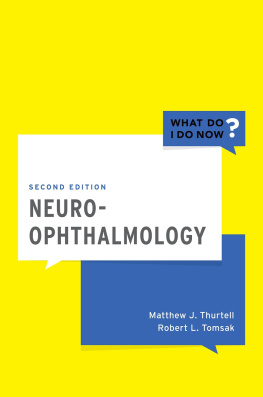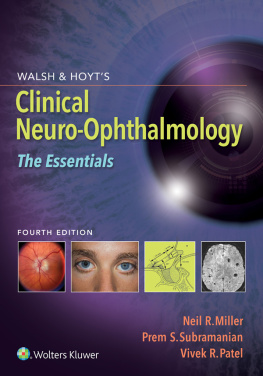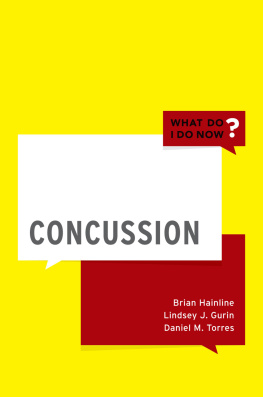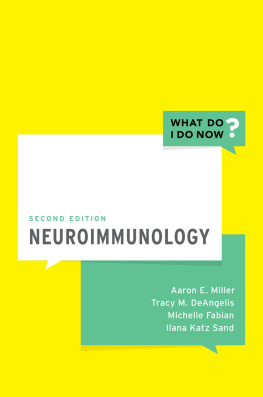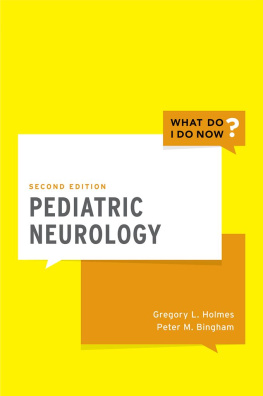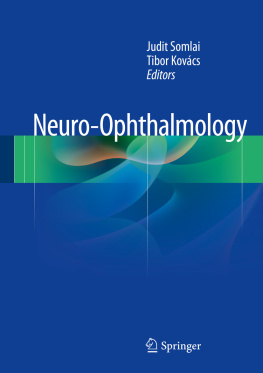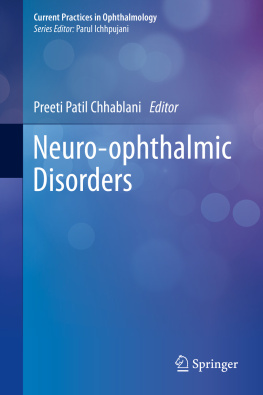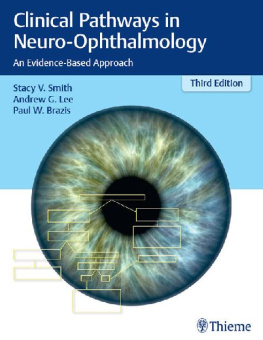Neuro-Ophthalmology
What Do I Do Now?
Series Co-Editors-in-Chief
Lawrence C. Newman, MD
Director of the Headache Division
Professor of Neurology
New York University Langone
New York, New York
Morris Levin, MD
Director of the Headache Center
Professor of Neurology
University of California, San Francisco
San Francisco, California
Other Volumes in the Series
Headache and Facial Pain
Epilepsy
Pain
Emergency Neurology
Neuroinfections
Neurogenetics
Neurotology
Pediatric Neurology
Neurocritical Care
Stroke
Peripheral Nerve and Muscle Disease
Cerebrovascular Disease
Movement Disorders
Womens Neurology
Neuroimmunology

Oxford University Press is a department of the University of Oxford. It furthers the Universitys objective of excellence in research, scholarship, and education by publishing worldwide. Oxford is a registered trade mark of Oxford University Press in the UK and certain other countries.
Published in the United States of America by Oxford University Press
198 Madison Avenue, New York, NY 10016, United States of America.
Oxford University Press 2019
First Edition published in 2011
Second Edition published in 2019
All rights reserved. No part of this publication may be reproduced, stored in a retrieval system, or transmitted, in any form or by any means, without the prior permission in writing of Oxford University Press, or as expressly permitted by law, by license, or under terms agreed with the appropriate reproduction rights organization. Inquiries concerning reproduction outside the scope of the above should be sent to the Rights Department, Oxford University Press, at the address above.
You must not circulate this work in any other form and you must impose this same condition on any acquirer.
Library of Congress Cataloging-in-Publication Data
Names: Thurtell, Matthew J., author. | Tomsak, Robert L., author.
Title: Neuro-ophthalmology / by Matthew J. Thurtell, Robert L. Tomsak.
Description: Second edition. | New York, NY : Oxford University Press, [2019] | Includes bibliographical references and index.
Identifiers: LCCN 2018054874 | ISBN 9780190603953 (pbk.)| ISBN 9780190603977 (epub)
Subjects: | MESH: Eye Diseasesdiagnosis | Nervous System Diseasescomplications | Cranial Nerve Diseases | Eye Diseasestherapy | Diagnosis, Differential | Case Reports
Classification: LCC RE75 | NLM WW 460 | DDC 617.7075dc23
LC record available at https://lccn.loc.gov/2018054874
This material is not intended to be, and should not be considered, a substitute for medical or other professional advice. Treatment for the conditions described in this material is highly dependent on the individual circumstances. And, while this material is designed to offer accurate information with respect to the subject matter covered and to be current as of the time it was written, research and knowledge about medical and health issues is constantly evolving and dose schedules for medications are being revised continually, with new side effects recognized and accounted for regularly. Readers must therefore always check the product information and clinical procedures with the most up-to-date published product information and data sheets provided by the manufacturers and the most recent codes of conduct and safety regulation. The publisher and the authors make no representations or warranties to readers, express or implied, as to the accuracy or completeness of this material. Without limiting the foregoing, the publisher and the authors make no representations or warranties as to the accuracy or efficacy of the drug dosages mentioned in the material. The authors and the publisher do not accept, and expressly disclaim, any responsibility for any liability, loss or risk that may be claimed or incurred as a consequence of the use and/or application of any of the contents of this material.
Robert B. Daroff, MDour mentor, colleague, and friendin recognition of his contributions to the field of neuro-ophthalmology.
Contents
Patients with neuro-ophthalmic conditions are commonly encountered in clinical practice, yet many clinicians feel ill prepared or uncomfortable when dealing with them. Those trained in neurology often feel uneasy when evaluating patients who have predominantly visual or ocular complaints, whereas those trained in ophthalmology often feel uncomfortable when evaluating those with predominantly neurologic complaints. Since a neuro-ophthalmologist is not always available for consultation, the clinician might be left wondering, What do I do now? when encountering a challenging case.
In this installment of the What Do I Do Now? series, we aim to provide a user-friendly manual that clinicians can reference when dealing with patients who have neuro-ophthalmic problems. The volume is divided into five sections that cover the main subdivisions of neuro-ophthalmic practice: (1) afferent (visual) disorders, (2) efferent (eye movement) disorders, (3) eyelid disorders, (4) pupil disorders, and (5) orbital and miscellaneous disorders. Each chapter includes a practical, case-based discussion on how to approach and manage a patient with a particular disorder. We discuss mainly common disorders, although we also consider some less common yet important conditions, as well as neuro-ophthalmic presentations of systemic and psychiatric disease. We have included a large number of efferent (eye movement) cases because many other handbooks focus on afferent (visual) disorders. We have based our recommendations on current evidence whenever possible. A list of key clinical points appears at the end of each chapter as well as a list of important references. In most chapters, tables and boxes summarize pertinent information. We include figures in most chapters to illustrate abnormal clinical signs or relevant imaging findings.
We designed the volume as a resource for neurologists and ophthalmologists at all levels of training. We hope that it will serve as a useful handbook in caring for patients with neuro-ophthalmic disease.
Many of the cases described in this book touch on controversial aspects of neuro-ophthalmology. We acknowledge those experts in the field who agreed to discuss their personal approaches to such cases with us. In particular, we thank Drs. Randy H. Kardon, Michael Wall, Richard C. Allen, and Wallace L. Alward for their helpful advice. We also thank the team at Oxford University Press, Craig Panner and Tiffany Lu, for their help in bringing this volume to completion.
You are called to see a 22-year-old woman who has had a subacute onset of vision loss in her right eye over several days with associated pain on eye movements. She has no past medical history and denies other neurologic symptoms. Examination shows visual acuities of 20/100 in the right eye and 20/15 in the left eye. She can identify only the control Ishihara color plate with the right eye, but she correctly identifies all plates with the left eye. Confrontation visual fields show a central scotoma in the right eye. Her pupils are equal and react to light, but there is a right relative afferent pupillary defect. Her funduscopic examination is normal.
What do you do now?
What do you do now?
T he patient in this scenario has had a subacute onset of painful monocular vision loss and exhibits the cardinal signs of an optic neuropathy: decreased visual acuity, a central visual field defect, dyschromatopsia, and a relative afferent pupillary defect. Her presentation is classic for optic neuritis. The clinical manifestations of optic neuritis vary depending on the portion of the optic nerve that is inflamed. For example, in retrobulbar optic neuritis, the most common subtype of optic neuritis, the retrobulbar portion of the optic nerve is inflamed and there is minimal, if any, optic disc edema. However, in neuroretinitis, the optic nerve head and peripapillary retina are inflamed, giving rise to optic disc edema and changes in the macula (i.e., fluid extending into the macula initially with development of retinal exudates to form a macular star) (see Case 7).

